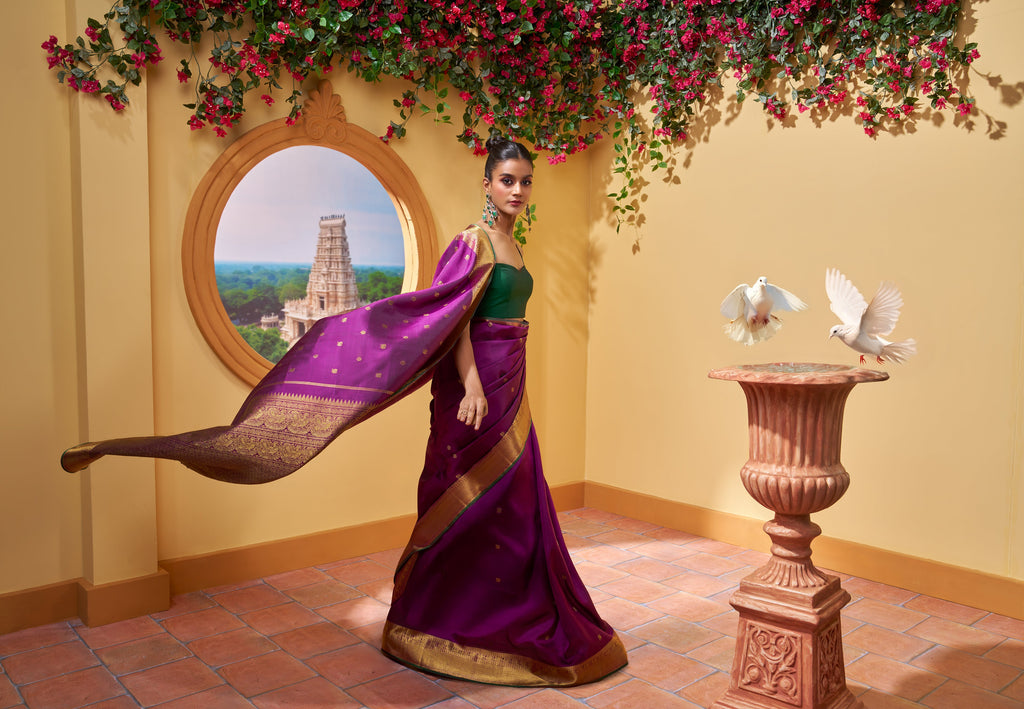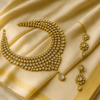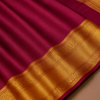Wrap It with Grace: Regional Saree Draping Styles Every Saree Lover Must Try

The saree is more than just six yards of fabric — it’s a timeless garment that transforms with every drape, taking on new personalities to match the wearer, the moment, and the mood. Unlike stitched attire, its beauty lies in versatility: a single saree can look formal, festive, or everyday-ready depending on how it is wrapped. Draping is not only an aesthetic choice but also a reflection of cultural identity and practical needs, shaped by climate, profession, and tradition. From graceful folds designed for rituals to practical styles made for movement, every region in India has perfected its own technique, turning the saree into a storytelling canvas. In this blog, we’ll journey across India to explore the regional draping styles every saree lover must try.
Why Draping Styles Matter in Saree Heritage
Draping a saree is not just about aesthetics — it is deeply tied to India’s cultural heritage. Each style carries symbolism, reflecting community identity, regional traditions, and even family customs passed down through generations. A drape can tell a story of devotion in temples, celebration during festivals, or grace on a wedding day. Beyond symbolism, practicality has shaped these styles: nine-yard sarees in Maharashtra allowed women to work and move freely, while back-tucked pallus in Coorg suited the hilly, rainy terrain. Today, draping continues to evolve under the influence of fashion shows, Bollywood, and global runways, where designers reimagine traditional styles with a contemporary twist. Understanding these roots sets the stage for exploring how each region of India wraps the saree with its unique touch of elegance.
Iconic Saree Draping Styles Across India
Nivi Drape – The Global Favorite from Andhra Pradesh & Telangana
The Nivi drape, originating in Andhra Pradesh and Telangana, is the most widely recognized saree style across the world. Its hallmark lies in neatly tucked front pleats that allow easy movement, paired with a gracefully pleated pallu falling over the left shoulder. Popularized through Indian cinema and embraced by modern brides, the Nivi has become synonymous with elegance and versatility. What makes this drape timeless is its adaptability — whether styled with a belt, brooch, or even layered with jackets, it balances tradition with modern flair, making it the go-to choice for daily wear as well as grand occasions.
Bengali Draping – The Grace of Wide Pallus
The Bengali drape is instantly recognizable by its voluminous pallu, thrown gracefully across both shoulders in two sweeping movements. This style exudes festivity and grandeur, making it a favorite during Durga Puja, weddings, and cultural gatherings. Unlike pleated pallus, the wide, flowing drape enhances the saree’s presence, particularly when paired with traditional red-and-white weaves or sarees with heavy borders. The double pallu arrangement not only adds drama but also creates an aura of effortless elegance, allowing the wearer to look both regal and rooted in tradition.
Gujarati Seedha Pallu – Embellishments in Spotlight
In Gujarat and parts of Rajasthan, the saree takes on a new personality through the seedha pallu drape. Here, the pallu is brought forward from the back, cascading across the torso in front. This unique style highlights the intricate embroidery, mirror work, and zari designs that Gujarati weavers are renowned for. Traditionally worn during festivals and weddings, it offers a practical yet ornamental approach to saree styling. By bringing the decorative elements to the forefront, the seedha pallu ensures that every detail of craftsmanship remains on display, making it a striking celebration of textile artistry.

Maharashtrian Nauvari – Warrior Elegance
The Maharashtrian Nauvari drape is a striking symbol of strength and grace. Unlike the six-yard saree, it uses a full nine yards, styled like a dhoti to allow complete freedom of movement. This practical design has deep historical roots, once worn by Maratha women warriors who needed agility on the battlefield. Today, the Nauvari continues to radiate energy and tradition, most notably during Ganesh Chaturthi celebrations and in the vibrant Lavani dance performances. Its fusion of functionality and elegance makes it more than just attire — it is an enduring reminder of women’s resilience and cultural pride.
Tamil & Kannada Kanchipuram Drapes – Temple Traditions
South India’s draping styles are inseparable from the grandeur of Kanchipuram silks. Tamil and Kannada traditions emphasize highlighting the saree’s temple borders and intricately woven pallus. Among them, the Madisar stands out — a nine-yard drape with strong religious and ritual significance, often reserved for Brahmin women during ceremonies. At weddings and temple rituals, this style transforms the saree into a flowing symbol of sanctity and heritage. Paired with the lustrous richness of Kanchipuram weaves, these drapes embody elegance, reverence, and a timeless connection to the region’s cultural and spiritual traditions.
Kodava Coorgi Style – The Back-Draped Grace
Distinct from mainstream saree draping, the Kodava style from Coorg is both practical and symbolic. Here, the pleats are tucked neatly at the waist while the pallu is drawn back and pinned over the shoulder. This reverse drape evolved to suit the hilly, rain-soaked terrain of Kodagu, making it functional for daily life and farming activities. Beyond practicality, the style serves as a cultural marker, instantly identifying the wearer as belonging to the proud Kodava community. The Coorgi drape remains a graceful reminder of how tradition adapts beautifully to lifestyle and landscape.
Assamese Mekhela Chador – Minimalist Sophistication
The Assamese saree drape, known as the Mekhela Chador, is distinct for its simplicity and grace. Instead of a single piece, it is crafted from two parts: the mekhela, a skirt-like bottom that is pleated and tucked, and the chador, the upper drape wrapped gracefully around the torso. Light, comfortable, and elegant, this style allows freedom of movement while maintaining a refined aesthetic. Often woven in delicate silks with motifs inspired by nature, the Mekhela Chador is prominently worn during Bihu festivals and weddings, embodying the understated charm of Assam’s textile heritage.
Tribal & North-Eastern Drapes – Identity through Textiles
Across Nagaland, Manipur, Mizoram, and Tripura, draping styles tell powerful stories of tribal identity. Unlike standardized saree forms, these drapes often resemble shawl-like or skirt-like ensembles, tailored for daily life and ritual occasions. Handwoven textiles are adorned with geometric motifs, flora, fauna, and symbolic colors that represent clan history, myths, and nature’s bounty. Each region innovates within its traditions, making these drapes living embodiments of cultural pride. Today, designers and models are reinterpreting these textiles on global fashion runways, blending heritage with modern silhouettes. This reinvention ensures tribal drapes remain visible, celebrated, and connected to the younger generation.
Saree Draping in Contemporary Fashion
Saree draping has found new expression in the modern fashion world, evolving beyond its traditional roots while keeping its soul intact. Fusion styles now pair sarees with belts, jackets, crop tops, and even sneakers, appealing to younger generations seeking comfort and edge. Bollywood icons and designers like Sabyasachi Mukherjee and Tarun Tahiliani have elevated draping into couture, showcasing inventive silhouettes on international platforms. Meanwhile, social media has democratized styling, with tutorials inspiring countless women to experiment confidently at home. From red carpets to everyday wear, the saree continues to reinvent itself, proving that this heritage garment is also a versatile global fashion icon.

How to Choose a Draping Style for Yourself
Selecting the right saree drape is about finding balance between tradition and personal comfort. Start by considering your body type and movement needs — some drapes, like the Nauvari, offer freedom, while others like the Nivi emphasize elegance. Match your style to the occasion: festive ceremonies may call for a Bengali or Gujarati drape, while weddings often embrace South Indian traditions. Above all, comfort is key, so experiment at home before big events to perfect the look. Choosing a drape becomes a way to honor heritage while expressing your unique personality and confidence.
Celebrating India’s Draping Diversity
The saree is a living canvas of tradition, pride, and reinvention. Each regional drape is not merely a style but a form of storytelling, carrying history, culture, and identity within its folds. By trying different draping techniques, saree lovers can celebrate the diversity of India while embracing their own individuality. From ritual-rich Madisars to global-ready Nivi styles, there’s a drape for every moment. Explore authentic Kanchipuram silks at Yaalika to experiment with these timeless drapes and discover your own graceful expression of heritage.




